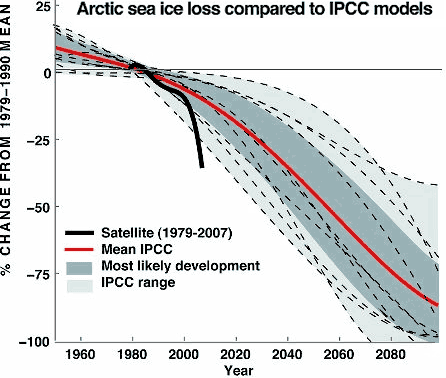Empirical evidence for positive feedback
Posted on 30 November 2007 by John Cook
In our recent post on model uncertainty, we found uncertainty is skewed towards higher climate sensitivity (and hence greater temperature change). However, this is based on the assumption that the climate system has net positive feedback. Do empirical observations confirm the existence of positive feedbacks - and more importantly, a net positive feedback?
Water Vapour as a positive feedback
Water vapour is the largest positive feedback in our climate system. The amplifying effect of water vapor is detected in Soden 2001 which observed the global cooling after the eruption of Mount Pinatubo. The cooling led to atmospheric drying which amplified the temperature drop.
Satellites have observed an increase in atmospheric water vapour by ~0.41 kg/m² per decade since 1988. A detection and attribution study (Santer 2007) found the primary driver of 'atmospheric moistening' was the increase in CO2 caused by the burning of fossil fuels. More on water vapour...
Carbon cycle feedback
That CO2 lags temperature is a popular skeptic argument but the implications are often overlooked. If rising temperatures lead to more CO2 outgassing from the oceans and other sources, that means current global warming will lead to more CO2 being released, amplifying the warming. While the mechanisms are not fully understood, the amount of CO2 change from changing temperatures and subsequent feedback have been observed in ice core records. Torn 2006 looks at the last 360,000 years and finds a warming of 1.5–4.5°C is amplified by CO2 feedback to 1.6–6.0°C. Scheffer 2006 focuses on the Little Ice Age, from 1500-1600 AD and estimates CO2 feedback will amplify warming by an extra 15 to 78%. More on CO2 lag...
The ocean's diminishing ability to absorb CO2
While the ocean absorbs around half of human CO2 emissions, observations indicate the oceans are losing their ability to absorb CO2. Quéré 2007 found the Southern Ocean has reached its saturation point, diminishing its ability to absorb more CO2. Similarly, CO2 absorption by the North Atlantic has dropped even more dramatically, halving over the past decade (Schuster 2007). If this trend continues, it potentially leads to a positive feedback where the oceans take up less CO2 leading to CO2 rising faster in the atmosphere. More on the carbon cycle...
Plankton growth slowing
Microscopic ocean plants called phytoplankton account for about half the transfer of carbon dioxide (CO2) from the environment into plant cells by photosynthesis. Land plants pull in the other half. However, warmer water creates more distinct ocean layers and limits mixing of deeper nutrient-rich cooler water with warmer surface water. The lack of rising nutrients keeps phytoplankton growth in check at the surface. Satellite observations of plankton growth have observed the rate at which plant cells take in CO2 has declined more than 6 percent globally over the last two decades (Gregg 2003).
Arctic sea ice melt
As Arctic sea ice melts, more ocean is exposed. Sea water is more effective at absorbing sunlight than ice which reflects sunlight back into space. Hence as sea ice melts, temperatures rise which causes more melt and so on. Arctic sea ice loss has not only has exceeded IPCC model projections - it has fallen below even the extreme lower limit of predictions (Stroeve 2007).
Melting Permafrost
The Arctic permafrost contains more carbon locked away in frozen soil than the entire atmosphere (Zimov 2006). On top of this, thawed permafrost can release its carbon as methane, 20 times as potent a greenhouse gas as carbon dioxide. Methane has been observed to be bubbling from Siberian thaw lakes five times higher than previously thought (Walter 2006).
Melting snow cover extent
A study on Northern Hemisphere snow cover extent over the period 1972–2006 (Déry 2007) found significant declines in snow cover during spring over North America and Eurasia. It also found an enhanced snow-albedo feedback over northern latitudes that acts to reinforce initial warming. Eg - as the snow melts, the ground and sea absorbs more warmth from the sun.
Putting it all together - climate sensitivity
While empirical observations confirm the existence of distinct positive feedbacks, the crucial question is what is the net positive feedback? Another way of asking this is what is climate sensitivity? Climate sensitivity is typically defined as the amount of temperature change for the doubling of atmospheric CO2. If there was no net positive feedback, climate sensitivity would be around 1°C. A number of studies calculate climate sensitivity directly from empirical observations, independent of models.
- Hansen 1993 looks at the last 20,000 years when the last ice age ended and calculates a climate sensitivity of 3 ± 1°C.
- Lorius 1990 examined Vostok ice core data and calculates a range of 3 to 4°C.
- Hoffert 1992 reconstructs two paleoclimate records (one colder, one warmer) to yield a range 1.4 to 3.2°C.
- Gregory 2002 used observations of ocean heat uptake to calculate a minimum climate sensitivity of 1.5.
- Tung 2007 performs statistical analysis on 20th century temperature response to the solar cycle to calculate a range 2.3 to 4.1°C.
So climate sensitivity is around 3°C. The warming from a doubling of CO2 amounts to around 1°C with positive feedbacks contributing another 2°C of warming. More on climate sensitivity...
UPDATE 5 Apr 2008: Tamino gives a good overview of feedbacks, both positive and negative.
UPDATE 22 Apr 2008: there is new evidence that the Arctic floor is thawing and releasing methane.































 Arguments
Arguments
























 0
0  0
0






Comments